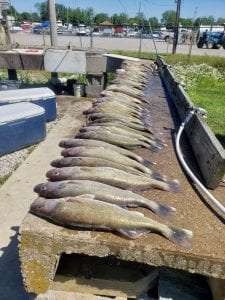Is your diet making you fat? Lake Erie Smallmouth Bass Diet
To all the fishermen and women out there. Have you wondered why Lake Erie smallmouth bass (Micropterus dolomieu) are so fat? In a recent research study done by Crane and Einhouse on Lake Erie, smallmouth bass diet data was used from the past 19 years to analyze the diet composition of a smallmouth bass diet in relation to the round goby (Neogobius melanostomus). Round gobies are an invasive species in the Great Lakes that came here from Eurasia in the ballast tanks of ships.
Round Goby
Photo credit: Paul Skawinski
The study was conducted in the eastern basin in Lake Erie near Buffalo, NY. Prior to the invasion of round goby into the Great Lakes, the smallmouth bass diet was just over 50% crayfish (Crane and Einhouse). After the invasion, round goby began to make up just under 75% of the smallmouth diet. For us humans, this is like typically eating a chicken drumstick for dinner and then switching to a routine T-bone steak and a potato every night. Diet alterations like this cause smallmouth bass to grow to sizes like the one shown below.
Smallmouth Bass
Photo credit: Jim Hanleys Fishing Charters
The round goby fight back against the smallmouth bass by predating on smallmouth bass nest sites. Even with round goby predation of smallmouth bass eggs, a higher percentage of smallmouth bass were found to survive to maturity than pre-invasion. The downside to these bass growing so rapidly is that the lifespan of the fish is decreased. With decreased lifespan, the less time the fish has to reproduce. During the study, bass were reaching sexual maturity earlier. They found the greatest size increase from ages 2-4 years. Crane and Einhouse expressed concern about the fecundity of the smallmouth bass in Great Lakes and thought that further research was needed in the following years.
Researchers and Charter fishermen agree that Great Lakes smallmouth bass have increased in size since the invasion of the round goby. As friendly advice, if you haven’t caught a Great Lake smallmouth, you have to try. You will not regret it.
Cited
Study Conducted Article-
D.P Crane, D. W. Einhouse. 2016. Changes in growth and diet of smallmouth bass following
invasion of Lake Erie by the round goby. Journal of Great Lakes Research. 42: 405-412.
https://www.sciencedirect.com/science/article/pii/S0380133015002713?via%3Dihub
Round Goby image-Paul Skawinski, fwwa.org
Smallmouth Bass image- Jim Hanleys Fishing Charters, Northeastoutdoors.com
Other Articles-
https://greatlakesecho.org/2015/02/12/good-news-smallmouth-bass-chow-down-on-invaders/











